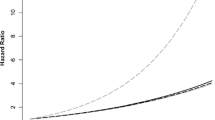Abstract
OBJECTIVE: To discover primary care physicians’ attitudes toward their abilities to detect and treat depression in the elderly.
DESIGN: A self-administered questionnaire sent to 1,000 primary care physicians in the state of Michigan.
SETTING: The survey was sent to physicians who practice general internal medicine or family medicine.
PARTICIPANTS: The questionnaire was sent to 500 MD and 500 DO physicians; equal representation was given to general internal medicine and family medicine. Of all 1,000 physicians, 60% (n=604) responded, 51% (n=309) were MD’s, 48% (n=295) were DO’s, 41% (n=245) were general internists, and 59% (n=359) were family medicine physicians.
MEASUREMENTS AND MAIN RESULTS: Despite positive attitudes about their skills for detecting and treating depression in the elderly, only one quarter of the respondents routinely used a screening tool in practice. Forty-one percent of all physicians were not aware of depression practice guidelines. Family physicians were more confident about their treatment skills than were general internists (85% vs 50%;x 2=11.42,p≤.003). Male physicians more often endorsed pharmacologic treatment, while female physicians more frequently used counseling and exercise techniques to treat depressed older patients. Half of all physicians felt knowledgeable about community resources to treat older depressed patients.
CONCLUSIONS: This survey identified several perceived needs for future targeted interventions: (1) additional Agency for Health Care Policy and Research guideline exposure for all primary care physicians, (2) targeted counseling skill intervention for male physicians and medication management for female physicians, and (3) additional continuing medical education intervention for practicing general internists. Further research is needed to correlate physician attitudes with ensuing behaviors to fully appreciate the nature of late-life depression treatment within the primary care arena.
Similar content being viewed by others
References
Rapp SR, Parisi SA, Wallace CE. Comorbid psychiatric disorders in elderly medical patients: a 1-year prospective study. J Am Geriatr Soc. 1991;39:124–31.
Wells KB, Stewart A, Hays RD, et al. The functioning and well-being of depressed patients: results from the Medical Outcomes Study. JAMA. 1989;262:914–9.
Cheah KC, Beard OW. Psychiatric findings in the population of ageriatric evaluation unit: implications. J Am Geriatr Soc. 1980;28:29–35.
Nielsen AC, Williams TA. Depression in ambulatory medical patients. Arch Gen Psychiatry. 1980;37:999–1004.
Callahan CM, Nienaber NA, Hendrie HC, Tierney WM. Depression in elderly outpatients: primary care physician’s attitudes and practice patterns. J Gen Intern Med. 1992,7:26–31.
Main DS, Lutz LJ, Barrett JE, Matthew J, Miller RS. The role of primary care clinician attitudes, beliefs and training in the diagnosis and treatment of depression. Arch Fam Med. 1993;2:1061–6.
Brody DS, Larson DB. The role of primary care physicians in managing depression. J Gen Intern Med. 1992;7:244–7.
Callahan CM, Hendrie HC, Dittus RS, Brater DC, Hui SL, Tierney WM. Improving treatment of late life depression in primary care: a randomized clinical trial. J Am Geriatr Soc. 1994;42:839–46.
Epi Info, version b. A word-processing, database, and statistics program for public health on IBM-compatible micro computers. Atlanta, GA: The Division of Surveillance and Epidemiology, Epidemiology Program Office, Center for Disease Control and Prevention (CDC), 1994.
Depression Guideline Panel. Depression in Primary Care: Volume 1, Detection and Diagnosis; Volume 2, Treatment of Major Depression. Clinical Practice Guideline, Number 5. AHCPR Publication No. 93-0551. Rockville, MD: U.S. Department of Health and Human Services, Public Health Service, Agency for Health Care Policy and Research, 1993;95–6.
Gilligan C. In a Different Voice. Cambridge, MA: Harvard University Press, 1982.
Sheikh JI, Yesavage JA. Recent evidence and development of a shorter version. Clin Gerontol. 1986;5:165–72.
Beck AT, Ward CH, Mendeson M, et al. An inventory for measuring depression. Arch Gen Psychiatry. 1961;4:561–71.
Spitzer RL, Williams JBW, Kroenke K, et al. Utility of a new procedure for diagnosing mental disorders in primary care: the PRIME-MD 1000 study. JAMA. 1995;272:1749–56.
Mulrow CD, Williams JW Jr, Gerety MB, et al. Case-finding instruments for depression in primary care settings. Ann Intern Med. 1995;122:913–21.
Author information
Authors and Affiliations
Additional information
Received from the Department of Psychiatry, Michigan State University, East Lansing.
Funded in full by a Michigan State All University Research Initiative Grant.
Rights and permissions
About this article
Cite this article
Banazak, D.A. Late-life depression in primary care. J Gen Intern Med 11, 163–167 (1996). https://doi.org/10.1007/BF02600269
Issue Date:
DOI: https://doi.org/10.1007/BF02600269




